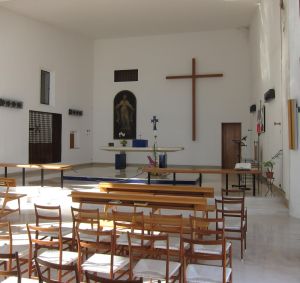Monastery of the Discalced Carmelites
Chiesa delle Carmelitane
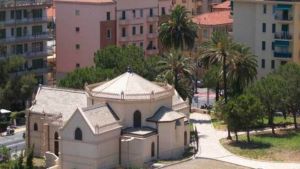 In the area of the current Corso Cavallotti, where the church stands today, there was once a small chapel dedicated to St. Nicholas of Bari, demolished at the end of the nineteenth century to allow the widening of the carriage road, which was located right on either side of the park of the villa known as the "Braje", consisting of an extensive manor house, vegetable garden, orchard and garden, belonging to the Borea d'Olmo family.
In the area of the current Corso Cavallotti, where the church stands today, there was once a small chapel dedicated to St. Nicholas of Bari, demolished at the end of the nineteenth century to allow the widening of the carriage road, which was located right on either side of the park of the villa known as the "Braje", consisting of an extensive manor house, vegetable garden, orchard and garden, belonging to the Borea d'Olmo family.
"We need a Carmel in San Remo", with these words the Holy Pope Pius X indicated to the Discalced Carmelites of Saint Die, driven out of France by the Napoleonic laws on the suppression of Religious Orders, to ask the French noblewoman Countess Renée d'Auvers for hospitality in her villa in San Remo, which was ceded to her at the end of the 19th century, together with the annexed properties, by the Borea d'Olmo family.
The Countess d'Auvers, descendant of Saint Louis King of France, welcomed the nuns, as the Pope had predicted, and later donated her villa to the Discalced Carmelites to be definitively transformed into a monastery in 1899. 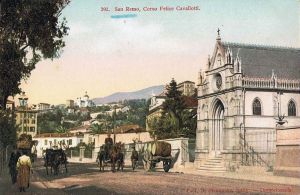 The present chapel, designed for Countess D'Auvers, was built in 1902 in neo-Gothic style by the architect Franco Tornatore, who admirably adapted this style to the particularly small size of the small building.
The present chapel, designed for Countess D'Auvers, was built in 1902 in neo-Gothic style by the architect Franco Tornatore, who admirably adapted this style to the particularly small size of the small building.
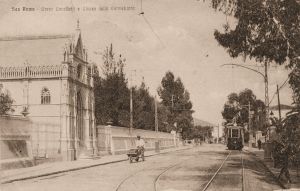 Thus since 1902 there has been a Carmel in San Remo, a place where an incessant prayer of praise and intercession rises to God.
Thus since 1902 there has been a Carmel in San Remo, a place where an incessant prayer of praise and intercession rises to God.
The Second World War did not spare the monastery, to which the bombardments had created considerable disruption; to this was added the particular conjuncture of the reconstruction and expansion of the city, which did not leave much room for silence, necessary for the Carmelite prayer life.
In 1958, as the area became too central and unsuitable for a cloistered place, the nuns sold the convent to the Municipality, which made public the park where the new railway station now stands and led the Community to wish for a transfer to a quieter area of the city.
Thus the suitable area was found, in the small convent structure with the small church dedicated to Our Lady of Mercy, protector of the inhabitants of Bonmoschetto, on the hill of flowers, which contemplates the sea and the city from above. 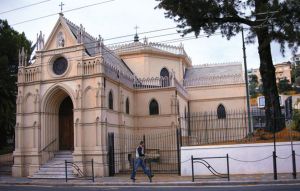 The church in Corso Cavallotti remained open for worship until February 1986, when it was closed to undergo a series of restoration and conservation works, financed by the Fondazione Cassa di Risparmio di Genova e Imperia.
The church in Corso Cavallotti remained open for worship until February 1986, when it was closed to undergo a series of restoration and conservation works, financed by the Fondazione Cassa di Risparmio di Genova e Imperia.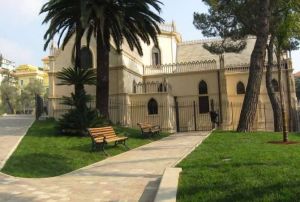 Finally, on 25 February 2009, after 17 years, the former Carmelite Park was inaugurated and opened to the public, a real heritage for the city, which had remained unused for so long. For generations of people from Sanremo it has been one of the ideal places to spend their free time.
Finally, on 25 February 2009, after 17 years, the former Carmelite Park was inaugurated and opened to the public, a real heritage for the city, which had remained unused for so long. For generations of people from Sanremo it has been one of the ideal places to spend their free time.
In 2008, thanks to the intercession of the parish priest of the church of Santa Maria degli Angeli, Don Giacomo Simonetti, the commitment of the diocesan Bishop Monsignor Alberto Maria Careggio and the sensitivity of the Prefectural Commissioner who at the time governed the fate of the city, Dr. Luigi Calandrella, was inaugurated at the Church of Carmel, the first Orthodox-Roman Orthodox parish in western Liguria dedicated to Saints Cyril and Methodius, patron saints of Europe in the same way as "our" Saint Benedict of Norcia, famous for having Christianised south-eastern Europe.
(from an article on "Riviera24").
Carmel Monastery
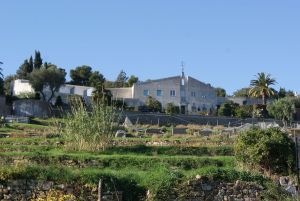 After the sale of the small church, on 4th November 1958 the community of the Discalced Carmelites of our city moved to a new monastery, located in Via Padre Semeria, on the hill at the foot of Coldirodi in the Bonmoschetto region.
After the sale of the small church, on 4th November 1958 the community of the Discalced Carmelites of our city moved to a new monastery, located in Via Padre Semeria, on the hill at the foot of Coldirodi in the Bonmoschetto region.
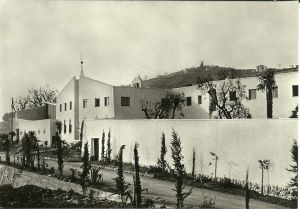 The convent, destined for cloistering and dedicated to Saint Elijah, is the work of the famous Milanese architect Gio Ponti (1891-1979), who built it from 1957 according to a project which, by his own admission, was the highest and most joyful moment of his career.
The convent, destined for cloistering and dedicated to Saint Elijah, is the work of the famous Milanese architect Gio Ponti (1891-1979), who built it from 1957 according to a project which, by his own admission, was the highest and most joyful moment of his career.
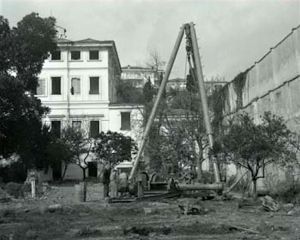 On the site where the monastery was to be built there was the rural church of Santa Maria in Bonmoschetto, until then home to a small community of friars and demolished to make way for the new construction.
On the site where the monastery was to be built there was the rural church of Santa Maria in Bonmoschetto, until then home to a small community of friars and demolished to make way for the new construction.
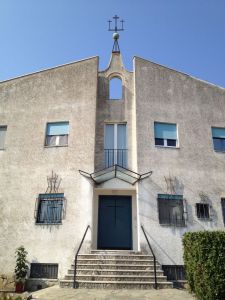
The building, also to respond to the need for deep and high spirituality of the cloistered nuns, blends harmoniously with the expressive solutions of simple and linear architecture in perfect harmony with the most frank and genuine Ligurian architectural tradition.
In the adjoining small church, equipped with large and bright stained glass windows, is preserved, among other things, the painting Madonna della Misericordia, also known as Santa Maria di Bonmoschetto, a work from the homonymous country chapel and made in 1760 by Dal Pozzo.
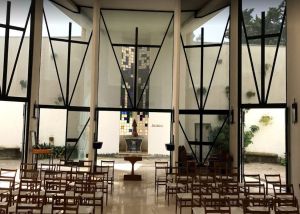 In the elegant interior cloister, the architectural motif is particularly noteworthy, consisting of agile pillars and entablatures reproducing a series of stylised crosses.
In the elegant interior cloister, the architectural motif is particularly noteworthy, consisting of agile pillars and entablatures reproducing a series of stylised crosses.
After the solemn consecration of the church, which took place on 7th June 1959, the nuns entered the new monastery definitively into seclusion.
On that occasion Pope John XXIII gave the Discalced Carmelite community the mandate to pray incessantly for the unity of the Church.
On 8 January 1989 the Monastery passed from the jurisdiction of the local Bishop to that of the Province.
The Community, made up of different nationalities, lives by praying and working, in the sharing of daily life made up of joys and labours, meetings and cultural diversity, to tell this splendid and welcoming city and the whole world that God calls us to unity and peace, in Him, our song and infinite love.
On August 16, 2019, after the prior favourable opinion of the Municipal Administration on the construction of an accommodation facility near the convent in Via Padre Semeria, the cloistered nuns, known for years to produce delicious organic jams, were able to open the gates of the Monastery to the public for the first time.
(from an article on "Riviera24").
(sources: texts by Andrea Gandolfo, notes from "Sanremo Storia e Anima di una città", others; images from private archives, WEB)





